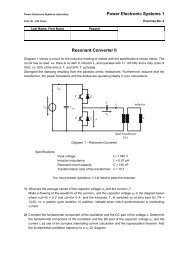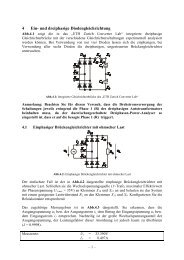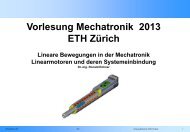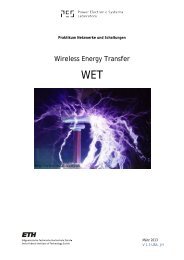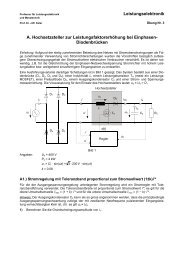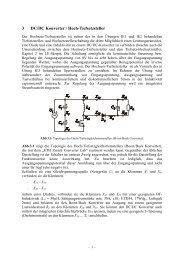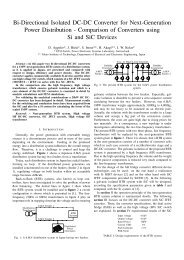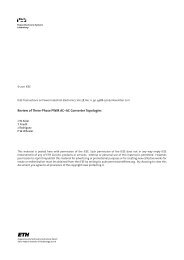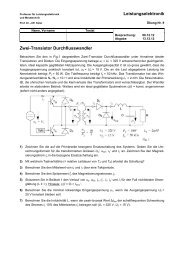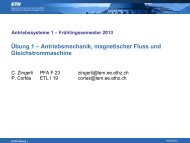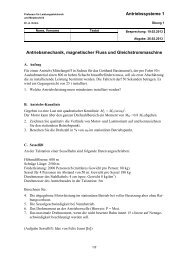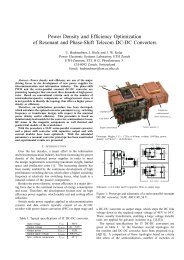Solid-State Transformer based on SiC JFETs for Future Energy ...
Solid-State Transformer based on SiC JFETs for Future Energy ...
Solid-State Transformer based on SiC JFETs for Future Energy ...
Create successful ePaper yourself
Turn your PDF publications into a flip-book with our unique Google optimized e-Paper software.
<str<strong>on</strong>g>Solid</str<strong>on</strong>g>-<str<strong>on</strong>g>State</str<strong>on</strong>g> <str<strong>on</strong>g>Trans<strong>for</strong>mer</str<strong>on</strong>g> <str<strong>on</strong>g>based</str<strong>on</strong>g> <strong>on</strong> <strong>SiC</strong> <strong>JFETs</strong> <strong>for</strong> <strong>Future</strong> <strong>Energy</strong><br />
Distributi<strong>on</strong> Systems<br />
D. Aggeler*, J. Biela*, J. W. Kolar*<br />
* ETH Zurich, Power Electr<strong>on</strong>ic Systems Laboratory, Switzerland<br />
I. INTRODUCTION<br />
In order to reduce the emissi<strong>on</strong> of greenhouse gas and replace<br />
the limited energy sources like coal, oil or uranium, the number of<br />
renewable energy sources is c<strong>on</strong>stantly growing. This development<br />
results in a rising number of distributed power plants, which are<br />
principally subject to substantial energy fluctuati<strong>on</strong>s. In order to<br />
easily c<strong>on</strong>nect the new energy sources to the grid and improve the<br />
power quality by harm<strong>on</strong>ic filtering, voltage sag correcti<strong>on</strong> and highly<br />
dynamic c<strong>on</strong>trol of the power flow new power electr<strong>on</strong>ic systems -<br />
so called Intelligent Universal / <str<strong>on</strong>g>Solid</str<strong>on</strong>g>-<str<strong>on</strong>g>State</str<strong>on</strong>g> <str<strong>on</strong>g>Trans<strong>for</strong>mer</str<strong>on</strong>g>s (SST) - are<br />
required. These interc<strong>on</strong>necting devices would enable full c<strong>on</strong>trol<br />
of magnitude and directi<strong>on</strong> of real and reactive power flow and<br />
could replace not c<strong>on</strong>trollable, voluminous and heavy line frequency<br />
trans<strong>for</strong>mers. Based <strong>on</strong> such devices a smart grid comparable to<br />
the internet, where a plug and playc<strong>on</strong>necti<strong>on</strong> of sources and loads,<br />
distributed energy uploads and downloads and energy routing <strong>for</strong><br />
transferring energy from the producer to the c<strong>on</strong>sumer, is possible.<br />
In the top of Fig.1 a c<strong>on</strong>venti<strong>on</strong>al interc<strong>on</strong>necting system <str<strong>on</strong>g>based</str<strong>on</strong>g><br />
<strong>on</strong> a back-to-back (BTB) c<strong>on</strong>verter and slow IGBT devices is shown.<br />
This system c<strong>on</strong>sists of ac-dc/dc-ac c<strong>on</strong>verters and two line-frequency<br />
trans<strong>for</strong>mers, which provide galvanic isolati<strong>on</strong> as well as voltage level<br />
c<strong>on</strong>versi<strong>on</strong> and which have a large volume and weight. In order to<br />
decrease the volume/weight of the system and reduce the raw material<br />
c<strong>on</strong>sumpti<strong>on</strong> new topologies [1]–[3], which replace the line frequency<br />
trans<strong>for</strong>mers by high frequency and high voltage trans<strong>for</strong>mers, have<br />
been proposed. These proposals are also <str<strong>on</strong>g>based</str<strong>on</strong>g> <strong>on</strong> IGBT devices,<br />
which significantly limit the feasible switching frequencies and the<br />
voltage level of the c<strong>on</strong>verter systems. In order to overcome these<br />
limits, new c<strong>on</strong>verter systems (cf. A, B & C in Fig.1) <str<strong>on</strong>g>based</str<strong>on</strong>g> <strong>on</strong> high<br />
voltage <strong>SiC</strong> <strong>JFETs</strong> cascades, which enable a much higher power<br />
density and a significantly higher system dynamic are presented in<br />
Secti<strong>on</strong>II of this paper. Furthermore, these systems require a lower<br />
number of c<strong>on</strong>verter stages, what results in lower system costs and<br />
a higher reliability.<br />
In Secti<strong>on</strong>III a 5kV/50kHz bi-directi<strong>on</strong>al, isolated dc-dc c<strong>on</strong>verter,<br />
which is a key element of the solid-state trans<strong>for</strong>mers, is discussed<br />
in detail. There the switching behaviour of the <strong>SiC</strong> switches, the<br />
design of the trans<strong>for</strong>mer and the achievable per<strong>for</strong>mance of the<br />
dc-dc c<strong>on</strong>verter are presented. Finally, the system parameters of<br />
a 1MW solid-state trans<strong>for</strong>mer <str<strong>on</strong>g>based</str<strong>on</strong>g> <strong>on</strong> the <strong>SiC</strong> dc-dc c<strong>on</strong>verter<br />
are calculated and the per<strong>for</strong>mance of the different topologies with<br />
respect to power density, efficiency and realisati<strong>on</strong> ef<strong>for</strong>t is compared<br />
in Secti<strong>on</strong>IV.<br />
II. TOPOLOGIES FOR SOLID-STATE TRANSFORMERS<br />
In Fig.1 three different topologies <strong>for</strong> realising a solid state<br />
trans<strong>for</strong>mer by applying a high-frequency (HF) and high voltage<br />
(HV) single phase trans<strong>for</strong>mer are shown. All of the c<strong>on</strong>cepts<br />
c<strong>on</strong>sist of a rectifier/inverter stage and a HF/HV dc-dc c<strong>on</strong>verter.<br />
Due to the high operating frequency the volume and the weight of<br />
the isolating trans<strong>for</strong>mer becomes very small in comparis<strong>on</strong> to line<br />
frequency <str<strong>on</strong>g>based</str<strong>on</strong>g> c<strong>on</strong>cepts. In order to limit the switching losses at<br />
the high frequencies switches <str<strong>on</strong>g>based</str<strong>on</strong>g> <strong>on</strong> <strong>SiC</strong> <strong>JFETs</strong>, which switch<br />
several kilovolts in less than 100ns, are applied. With these devices<br />
operating frequencies of several tens of kilohertz are possible. A<br />
blocking voltage in the range of several kilovolts is achieved by<br />
a series c<strong>on</strong>necti<strong>on</strong> of <strong>JFETs</strong> (Super Cascode). There, the voltage<br />
balancing between the single devices is crucial and could be achieved<br />
by c<strong>on</strong>necting small resistors/capacitors between the gate and the<br />
C<strong>on</strong>venti<strong>on</strong>al System:<br />
3-phase<br />
50Hz/60Hz<br />
<strong>Future</strong> Systems:<br />
A.<br />
3-phase<br />
B.<br />
3-phase<br />
C.<br />
3-phase<br />
AC-DC<br />
AC-DC<br />
2/3-level<br />
c<strong>on</strong>verter<br />
DC-DC<br />
DC-AC<br />
2/3-level<br />
c<strong>on</strong>verter<br />
C<strong>on</strong>verter Cell = Module<br />
C<strong>on</strong>verter Cell<br />
C<strong>on</strong>verter Cell<br />
50Hz/60Hz<br />
DC-AC<br />
AC-DC DC-DC DC-AC<br />
AC-DC<br />
Module<br />
Module<br />
DC-DC<br />
DC-AC<br />
3-phase<br />
3-phase<br />
3-phase<br />
3-phase<br />
Fig. 1: C<strong>on</strong>venti<strong>on</strong>al system with the bulky line frequency trans<strong>for</strong>mer;<br />
<strong>Future</strong> solid-state trans<strong>for</strong>mers: A. single-phase modular c<strong>on</strong>verter cells,<br />
B. 3-level c<strong>on</strong>verter/inverter and 2-level dc-dc c<strong>on</strong>verter, C. 3-level<br />
topology system design.<br />
source of the single <strong>JFETs</strong> as will be explained in more detail in<br />
secti<strong>on</strong> III.<br />
Based <strong>on</strong> the Super Cascode in topology A a 2-level single phase<br />
inverter/rectifier stage and a 2-level dc-dc c<strong>on</strong>verter are combined in a<br />
c<strong>on</strong>verter cell. In order to reduce the required blocking voltage of the<br />
semic<strong>on</strong>ductors several cells are c<strong>on</strong>nected in series. Furthermore, the<br />
three c<strong>on</strong>verter branches are star c<strong>on</strong>nected. With this c<strong>on</strong>cept SSTs<br />
<strong>for</strong> medium voltage level (11-35kV) applicati<strong>on</strong>s can be realised.<br />
Based <strong>on</strong> the available switches also a direct 3-phase topology<br />
as shown in Fig.1 B and C could be used <strong>for</strong> AC voltages up to<br />
10kV. Due to the reduced number of required switches the system<br />
costs reduce and the reliability increase. There, a 3-level boost<br />
rectifier/inverter stage is applied, which allows higher operating<br />
voltages than a 2-level c<strong>on</strong>cept. In topology B the DC link is split<br />
up, so that a series c<strong>on</strong>necti<strong>on</strong> of two 2-level dc-dc c<strong>on</strong>verter as in<br />
topology A is possible. There, the balancing of the two dc voltages<br />
is possible with the proper c<strong>on</strong>trol of the AC-DC stage. In topology<br />
C 3-level branches are also utilised in the dc-dc c<strong>on</strong>verter so that a<br />
single dc-dc c<strong>on</strong>verter cell is sufficient.<br />
In the final paper a detailed comparis<strong>on</strong> of the topologies and
C<strong>on</strong>trol<br />
Board<br />
5kV Input Side<br />
<str<strong>on</strong>g>Trans<strong>for</strong>mer</str<strong>on</strong>g><br />
Gate Drive &<br />
Measurement Board<br />
Heat Sink<br />
Fan<br />
135 mm<br />
DC link<br />
Ceramic Capacitors<br />
<strong>on</strong> the Power Board<br />
700V Output Side<br />
218 mm<br />
Fig. 2: 3D-Model of the proposed dc-dc c<strong>on</strong>verter.<br />
176 mm<br />
c<strong>on</strong>cepts <str<strong>on</strong>g>based</str<strong>on</strong>g> <strong>on</strong> 3-phase trans<strong>for</strong>mers, which allow a further<br />
volume reducti<strong>on</strong>, as well as the achievable system per<strong>for</strong>mance with<br />
a 30kV <strong>SiC</strong> switch are presented.<br />
III. 5 KV/50 KHZ BI-DIRECTIONAL DC-DC CONVERTER<br />
A key element of all topologies is the HF/HV dc-dc c<strong>on</strong>verter,<br />
which enables a significant volume reducti<strong>on</strong> of SSTs compared to<br />
line frequency c<strong>on</strong>cepts. There<strong>for</strong>e, the design and the per<strong>for</strong>mance<br />
of a 25kW c<strong>on</strong>verter operating at a DC link voltage of 5kV and an<br />
operating frequency of 50kHz is discussed in detail in the following.<br />
In Fig.2 a 3D model of the system is depicted, which has a power<br />
density of 4.8kW/ltr. and an efficiency of 97%. There, a <strong>SiC</strong><br />
SuperCascode with a blocking voltage of 7.5kV and a trans<strong>for</strong>mer<br />
<str<strong>on</strong>g>based</str<strong>on</strong>g> <strong>on</strong> ferrite, which are explained in the following, are applied.<br />
A. <strong>SiC</strong> Super Cascode<br />
The <strong>SiC</strong> Super Cascode c<strong>on</strong>sist of a low-voltage Si MOSFET, a<br />
<strong>SiC</strong> JFET cascade, whereas the number of series c<strong>on</strong>nected devices<br />
depends <strong>on</strong> the blocking voltage, and the gate diodes <strong>for</strong> voltage<br />
balancing and turning the upper <strong>JFETs</strong> <strong>on</strong> and off. The basic<br />
operating principle of the <strong>SiC</strong> Super Cascode is described in [4]<br />
and the c<strong>on</strong>cept <strong>for</strong> voltage balancing is derived in [5]. In Fig.4 the<br />
measured switching wave<strong>for</strong>ms <strong>for</strong> an operating voltage of 5kV and 5<br />
cascaded 1500V <strong>JFETs</strong> are depicted, which show that the rise and fall<br />
times are below 100ns. This fast switching transiti<strong>on</strong> in combinati<strong>on</strong><br />
with the ZVS switching c<strong>on</strong>diti<strong>on</strong> drastically reduces the switching<br />
losses. In the final paper simulati<strong>on</strong> results <strong>for</strong> a 30kV switch <str<strong>on</strong>g>based</str<strong>on</strong>g><br />
<strong>on</strong> 6.5kV <strong>JFETs</strong> will be presented, which significantly extends the<br />
useable power and voltage range of this c<strong>on</strong>cept.<br />
B. 50 kHz-5 kV <str<strong>on</strong>g>Trans<strong>for</strong>mer</str<strong>on</strong>g><br />
Besides stable and fast operati<strong>on</strong> of the <strong>SiC</strong> SuperCascode, the<br />
design of the integrated HF/HV trans<strong>for</strong>mer (cf. Fig.4 is very<br />
important <strong>for</strong> the SST. Due to the high operating frequencies the HF<br />
losses in the windings must be limited by a careful design, so that the<br />
efficiency of the trans<strong>for</strong>mer is high and its volume low. Furthermore,<br />
the very step voltage transiti<strong>on</strong>s, which are required <strong>for</strong> the reducti<strong>on</strong><br />
of the switching losses, result in a n<strong>on</strong> uni<strong>for</strong>m voltage distributi<strong>on</strong><br />
within the winding during and shortly after the rising/falling edges.<br />
In the final paper the detailed design of the trans<strong>for</strong>mer and the<br />
calculated transient voltage distributi<strong>on</strong> are presented.<br />
J 5<br />
D 4<br />
J 4<br />
D 3<br />
J 3<br />
J 2<br />
J 1<br />
M 1<br />
D 2<br />
D 1<br />
155 mm<br />
80 mm<br />
76 mm<br />
A. B.<br />
Fig. 3: A.: <strong>SiC</strong> JFET/Si MOSFET Cascade - Super Cascode. B.:<br />
5 kV/50 kHz trans<strong>for</strong>mer.<br />
Voltage [ kV ]<br />
Voltage [ kV ]<br />
6.0<br />
4.0<br />
2.0<br />
0<br />
6.0<br />
4.0<br />
2.0<br />
0<br />
Voltage<br />
Current<br />
0 40 80 120 160 200<br />
Time [ ns ]<br />
2.7 A<br />
4.0 A<br />
5.6 A<br />
7.3 A<br />
9.7 A<br />
0 35 70 105 140 175<br />
Time [ ns ]<br />
6<br />
4<br />
2<br />
0<br />
Current [ A ]<br />
Voltage [ kV ]<br />
Voltage [ kV ]<br />
6.0<br />
4.0<br />
2.0<br />
0<br />
Current<br />
Voltage<br />
0 40 80 120 160 200<br />
Time [ ns ]<br />
6.0<br />
5.0<br />
v ds,J4<br />
4.0<br />
3.0<br />
2.0<br />
1.0<br />
0<br />
v ds,J3<br />
v ds,J2<br />
v ds,J1<br />
10x v ds,MOSFET<br />
-1.0<br />
0 0.8 1.6 2.4 3.2 4.0<br />
Time [ us ]<br />
Fig. 4: <strong>SiC</strong> Super Cascode characteristics: Turn <strong>on</strong> and turn off behaviour<br />
(at different current), voltage distributi<strong>on</strong>.<br />
IV. 1 MW SMART BTB SYSTEM (MODULAR BUILT)<br />
For comparing the different topologies and relating it to the<br />
existing line frequency c<strong>on</strong>cepts a detailed per<strong>for</strong>mance analysis of<br />
the proposed BTB c<strong>on</strong>versi<strong>on</strong> systems with <strong>SiC</strong> SuperCascodes and<br />
the per<strong>for</strong>mance of a 1 MW system will be presented in the final<br />
paper(TableI estimated).<br />
Topology A. B. C.<br />
Switching Frequency<br />
50 kHz<br />
Number of Modules 40 20 20<br />
Volume/Module [dm 3 ] 6.3 13.5 13.6<br />
Number of <strong>SiC</strong> Super Cascodes/Module 16 40 40<br />
Total Switch Losses [kW] 27 34 34<br />
<str<strong>on</strong>g>Trans<strong>for</strong>mer</str<strong>on</strong>g> Losses [kW] 2.4 2.4 2.4<br />
Efficiency [%] 97 96 96<br />
TABLE I: Per<strong>for</strong>mance of a 1 MW system <str<strong>on</strong>g>based</str<strong>on</strong>g> <strong>on</strong> the measurement<br />
and design results of the bi-directi<strong>on</strong>al dc-dc c<strong>on</strong>verter.<br />
V. CONCLUSION<br />
In this paper three new topologies <strong>for</strong> solid-state trans<strong>for</strong>mers<br />
(SST) <str<strong>on</strong>g>based</str<strong>on</strong>g> <strong>on</strong> <strong>SiC</strong> Super Cascodes are presented and compared.<br />
Furthermore, a detailed analysis of the design and the per<strong>for</strong>mance<br />
of a 5kV/50kHz dc-dc c<strong>on</strong>verter with a power density of 4.8kW/ltr.,<br />
which is a core element of the SSTs, is presented. There, also<br />
the operating principle of the Super Cascode and voltage balancing<br />
methods as well as the detailed design of the high voltage trans<strong>for</strong>mer<br />
are explained. Based <strong>on</strong> these results the parameters of a 1MW SST,<br />
which shows an efficiency of approximately 97% and a volume of<br />
0.27m 3 , are derived and discussed.<br />
REFERENCES<br />
[1] L. Heinemann, “An actively cooled high power, high frequency trans<strong>for</strong>mer<br />
with high insulati<strong>on</strong> capability,” in APEC, vol. 1, 2002, pp. 352–<br />
357.<br />
[2] J. Biela, D. Aggeler, S. Inoue, H. Akagi, and J. W. Kolar, “Bidirecti<strong>on</strong>al<br />
isolated dc-dc c<strong>on</strong>verter <strong>for</strong> next-generati<strong>on</strong> power distributi<strong>on</strong><br />
- comparis<strong>on</strong> of c<strong>on</strong>verters using Si and <strong>SiC</strong> devices,” vol. 127, 2007,<br />
IEEJ Trans.<br />
[3] H. Akagi, “The next-generati<strong>on</strong> medium-voltage power c<strong>on</strong>versi<strong>on</strong> systems,”<br />
Journal of the Chinese Institute of Engineers, vol. 30, no. 5, pp.<br />
1117–1135, Feb. 2007.<br />
[4] P. Friedrichs, H. Mitlehner, R. Schorner, K.-O. Dohnke, R. Elpelt, and<br />
D. Stephani, “Stacked high voltage switch <str<strong>on</strong>g>based</str<strong>on</strong>g> <strong>on</strong> <strong>SiC</strong> V<strong>JFETs</strong>,” in<br />
Power Semic<strong>on</strong>ductor Devices and ICs, 2003. Proceedings. ISPSD ’03.<br />
2003 IEEE 15th Internati<strong>on</strong>al Symposium <strong>on</strong>, 14-17 April 2003, pp. 139–<br />
142.<br />
[5] D. Aggeler, J. Biela, and J. W. Kolar, “A compact, high voltage 25kW,<br />
50kHz DC-DC c<strong>on</strong>verter <str<strong>on</strong>g>based</str<strong>on</strong>g> <strong>on</strong> <strong>SiC</strong> <strong>JFETs</strong>,” in APEC, 2008.<br />
6<br />
4<br />
2<br />
0<br />
Current [ A ]



